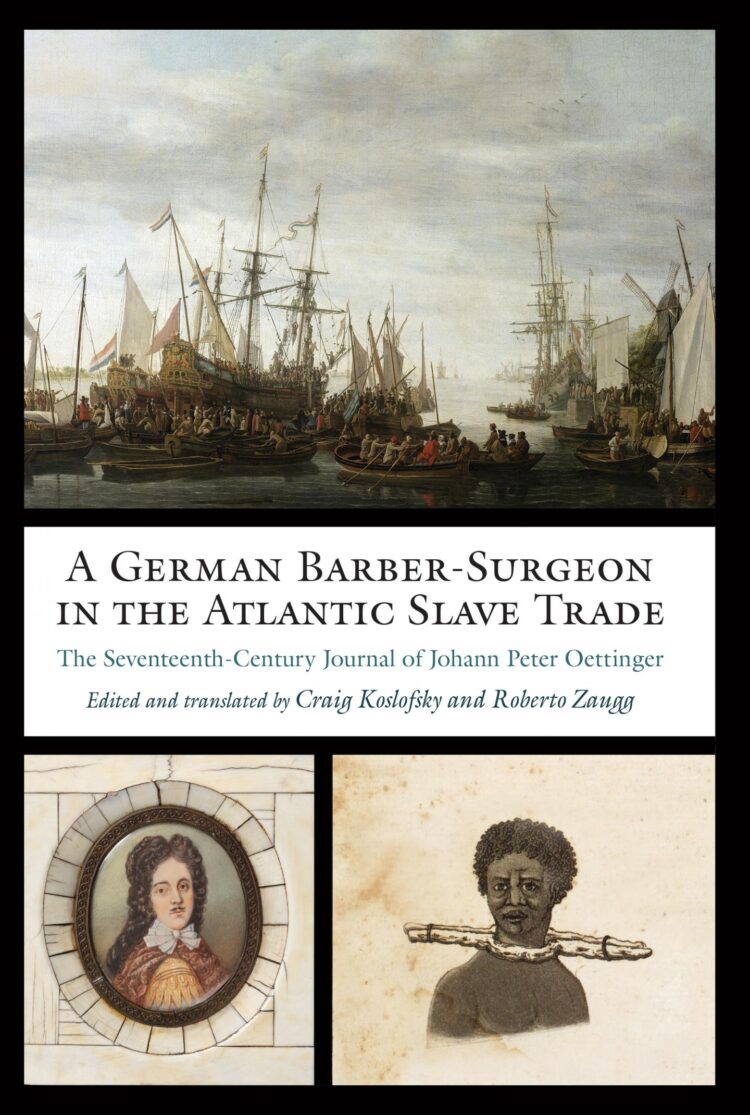
Credit: Book cover courtesy the University of Virginia Press
CHAMPAIGN, Ill. — The trade that brought enslaved Africans to the New World was not just a story of slave ship captains and their human cargo. Many other people were part of the machinery, drawn by money or opportunity, some from surprising places.
One of them was a young German barber-surgeon who kept a journal.
Johann Peter Oettinger inspected African captives prior to their branding and sale into slavery, tried to keep them healthy on the Middle Passage across the Atlantic Ocean, and made note of their resistance and their deaths. His account also recorded many other experiences and observations from travels within and between Europe, coastal West Africa and the Caribbean in the late 1600s.
Three hundred years later, two historians, working separately, discovered Oettinger’s journal in a Berlin archive, joined forces to translate it into English and wrote a book that sets it in the context of its time.
Through Oettinger’s account, “we can reflect on daily life in the slave trade, its quotidian brutality and the willingness of ordinary men to enact it,” wrote co-authors Craig Koslofsky and Roberto Zaugg. “It bears straightforward witness to the commodification of human life and to the banality of evil.”
Koslofsky is a history professor at the University of Illinois Urbana-Champaign and Zaugg is a history professor at the University of Zurich. Their book is “A German Barber-Surgeon in the Atlantic Slave Trade.”
Oettinger’s journal, Koslofsky said, “puts a human face on the slave trade and puts it in a vivid light,” though often through plain and terse daily entries.
“Oettinger describes things very naively,” Koslofsky said, “and because he’s going to places that nobody in Germany has even heard of, he describes things in a little more detail than other accounts of Atlantic slavery from this period. He’s also probably the lowest ranking in social hierarchy of any author writing about West Africa at this time. He identifies more with ordinary people.”
That’s the case because the barber-surgeon was regarded as more of a craftsman, on the level of a butcher or tailor, rather than a university-educated physician. His job was hands-on care of the human body: dressing wounds, stitching up cuts, treating fractures, ulcers and burns, as well as often bloodletting, teeth pulling, shaving and cutting hair.
None of this means Oettinger had any moral qualms about slavery, Koslofsky said. Few at the time did, except for those enslaved. Oettinger described the trade in humans without questioning it. It was simply part of the world he found.
He is, however, able to provide “a glimpse at real African people” and has “an eye for African agency,” Koslofsky said. “He’s pretty good at recording resistance among the enslaved, resistance of all kinds,” in the form of suicides, escapes and an attempted mutiny aboard ship, which resulted in the brutal execution of the ringleader.
Oettinger also writes extensively about the coastal Africans who are supplying slaves from farther inland, in particular in present-day Benin. His account of African life and culture in West Africa, at sites from Mauritania to São Tomé, is one of the few among Europeans of this period, Koslofsky said.
His story also reads, in places, as an adventure tale. His ship, operated by a German-based trading company, was threatened numerous times from a distance by ships of other countries or by pirates. On a return trip from the Caribbean, his ship was fired on, captured and burned by a French fleet. Slave-produced sugar, tobacco and cotton that Oettinger had purchased and hoped to profit from were destroyed.
Death from disease and other causes was a constant on board the ship, for both crew and captives, and his journal routinely records the dumping of bodies into the sea. He describes several deadly shark attacks off the African coast. He also makes note of when food has gone bad or is running out.
His journal also records years of trudging across Europe, seeking employment as part of his training, before and after his slave-trade voyages.
“So we have a weird experience where we get to know this guy,” Koslofsky said, “and can’t help but kind of take his side because he’s a poor young journeyman, trying to make his way in the world. And then he becomes complicit in the slave trade. So there’s kind of an interesting moral challenge.
“His complicity is something that we should all contemplate as we’re thinking about our ancestors who benefited from the slave trade, and how that trade functioned. Because Oettinger is an ordinary guy from central Germany, miles from the ocean, and yet he gets thrown into it.”
###
Media Contact
Craig Chamberlain
[email protected]
Original Source
http://news.





